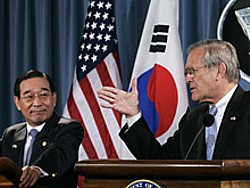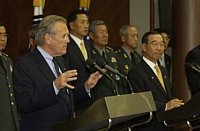The US Nuclear Umbrella Over South Korea
The United States has maintained a nuclear umbrella over
South Korea since the Korean War, when nuclear weapons were first deployed
to the Pacific for potential use against China in case U.S. forces fighting
in Korea were defeated by Chinese forces. In
January 1958, the first nuclear weapons were deployed to South Korea and
nuclear weapons remained in the country until late 1991 when the last
weapons were withdrawn.
Since 1991, the United States has sought to reassure South Korea -- and
signal to North Korea -- that the nuclear umbrella is intact despite the
absence of nuclear weapons on the ground, made up by nuclear weapons
deployed in the United States and onboard ballistic missile submarines
deployed in the Pacific Ocean.
Below follows brief overviews and copies of recent
reaffirmations of the U.S. nuclear umbrella over South Korea.
 |
|
Shortly after the North Korean
nuclear test, U.S. Defense Secretary Donald Rumsfeld and
Korean Defense Minister Yoon Kwang Ung reaffirmed the nuclear umbrella over
South Korea. |
Nuclear Brief October 23, 2006
Nuclear Umbrella Reaffirmation Follows Nuclear Korean Nuclear Test
Less than two weeks after North Korea tested a nuclear
devise, the United States and South Korea issued a
joint communiqué from the 38th Security Consultative Meeting that
reaffirmed the U.S. nuclear umbrella over South Korea. Unlike the 2005
communiqué (see below), the 2006 statement reaffirmed the "continuation of
the extended deterrence offered by the U.S. nuclear umbrella."
Analysis: Feeding North Korean Threat Perceptions
The 2006 reaffirmation appeared in the third paragraph of the communiqué,
four paragraphs up from the 2005 statement, and was made in the context of
the North Korea test on October 9. The statement explicitly mentioned
"extended deterrence," rather than the more ambiguous "provisions of the
nuclear umbrella" term used in the 2005 communiqué. Presumably, the
intension has been to make the reaffirmation more a little more explicit
given the new circumstances.
One audience for this statement is South Korea, in an
apparent attempt to reassure Seoul and thwart any thoughts about a need to
develop nuclear weapons. This message is also intended for other non-nuclear
countries, including Japan, that there are real security benefits from
abstaining from developing nuclear weapons and adhering to the provisions of
the Non-Proliferation Treaty.
Another audience is North Korea, making it a little
clearer than before that any aggressive moves by them against the South
could, potentially, trigger a nuclear response from the United States. This
message is also intended to other potential nuclear proliferators such as
Iran.
Yet the reaffirmation of the nuclear umbrella comes at a
time when it seems urgent to limit the role of nuclear weapons in the
region, not reaffirm the role. President George Bush's
condemnation of North Korea's nuclear test called for a "denuclearized"
Korean Peninsula, yet that vision seems unattainable if all sides continue
to insist that nuclear weapons are vital for their national security. The
North Korean test suggests that the time has come to design a security
structure in the region that does not rely on nuclear weapons.
 |
|
U.S. Defense Secretary Donald Rumsfeld and
Korean Defense Minister Yoon Kwang Ung chose not to modify the
U.S. nuclear umbrella over South Korea. |
Nuclear Brief October 24, 2005
Nuclear Umbrella Over South Korea Reaffirmed
The 37th Security Consultative Meeting
between the United States and South Korea on October 21, 2005, decided to reaffirm the
continued existence of a U.S. nuclear umbrella over South Korea rater
than modify it to appease North Korean concerns.
The
Joint Communiqué from the meeting states
that "Secretary Rumsfeld reaffirmed the U.S. commitment to...the
continued provision of a nuclear umbrella for [South Korea], consistent
with the Mutual Defense Treaty."
In reaffirming the nuclear umbrella, Rumsfeld and Yoon noted "North
Korea's continued development of WMD, and long-range missiles."
They said that "a solid combined defense posture should be
maintained in order to secure peace and stability on the Korean
Peninsula and in Northeast Asia." The communiqué stated that the ROK-U.S. combined force capability "remains at peak readiness."
Analysis: Missed Opportunity?
The reaffirmation of the U.S. nuclear
umbrella over South Korea comes only a month
after the completion of the fourth round of the Six Part Talks, where
North Korea agreed to
"abandoning all nuclear weapons and existing nuclear
programs and returning, at an early date, to the Treaty on the
Non-Proliferation of Nuclear Weapons and to IAEA safeguards." The United
States pledged at the same meeting that "it has no nuclear weapons on
the Korean Peninsula and has no intention to attack...the DPRK with
nuclear...weapons."
In light of that development, General Leon LaPorte,
the commander of U.S. Forces in South Korea, told reporters prior to the
37th Security
Consultative Meeting discussions included whether to soften the U.S.
nuclear umbrella. According to several press reports, LaPorte said the
language on the nuclear pledge was the subject of
last minute talks between Rumsfeld's policy team and the South Korea
defense ministry. "I think that's being discussed right now between OSD
policy and MND policy. So that'll get worked out here I think in the
next two hours," LaPorte told reporters traveling with Secretary
Rumsfeld.
 |
|
General Leon LaPorte (left) told reporters that
the 37th
Security Consultative Meeting considered whether to soften the
U.S. nuclear umbrella over South Korea. |
Instead, the nuclear pledge was reaffirmed with no
apparent change. Why would the United States and South Korea see a need, at
this particular time, to reaffirm the nuclear umbrella?
The answer may be a combination of several
considerations, foremost a "wait and see" if North Korea carries through
on its pledge. After all, North Korea publicly declared for
the first time on February 10, 2005, that it had manufactured nuclear
weapons "for self-defense," and on March 31, it added that it was a
"full-fledged nuclear weapons state." Declaration aside, U.S.
intelligence has assumed for more than a decade that North Korea
probably has assembled several nuclear weapons. Yet neither side has
provided evidence to back up their claim.
Another consideration may have been to assure South
Korea of continued overall U.S. defense commitment. Changing the nuclear
umbrella at the same time that the U.S. is reducing its conventional
forces in South Korea may have been too much too soon.
Yet another consideration may have been China. The
U.S. nuclear umbrella in the region is not focused on North Korea but
also incorporates planning against potential Chinese aggression.
Nullifying or weakening the umbrella over the Peninsula, some would
argue, might leave South Korea open to potential Chinese coercion and
send the wrong signal at a time when China is seem by some as trying to
pressure Taiwan and reassert its influence in the region.
Finally, there is the issue of extended deterrence in
the region in general. Japan is covered by part of the same umbrella as
South Korea. Some may have been concerned that any weakening of the U.S.
nuclear umbrella in the region could increase Japanese doubts about its
own security arrangement with the United States and spawn Japan's own
nuclear weapons ambitions.
Despite such considerations, the decision of the
37th Security
Consultative Meeting to reaffirm the nuclear
umbrella over South Korea appears to have missed an important
opportunity to use the status of the umbrella as an additional incentive
to move the nuclear agenda on the Korean Peninsula forward. Rather than
simply reaffirming the umbrella as is, the United States and South Korea
could have made it conditional on North Korea carrying through on its
pledges to give up nuclear weapons and rejoin the Non-Proliferation
Treaty.
An unmodified umbrella makes the U.S. look
disingenuous when it says it has no intention to attack North Korea with
nuclear weapons, and it gives North Korea an easy excuse to question the
credibility of the
Joint
Statement of the Fourth Round of the Six-Party Talks. |

